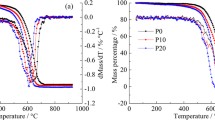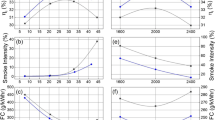Abstract
Powder X-ray diffraction (XRD), scanning electron microscopy (SEM), and tunneling electron microscopy (TEM) studies of two solid vehicle wastes (pollutants) from petrol- and diesel-fueled engines of Kolkata (India) have detected a significant amount of ultrafine particles in the nanometer scale in these wastes. Both powder XRD and selected area electron diffraction from TEM have confirmed the existence of inhomogeneous distribution of nanocrystallites in these pollutants. Energy dispersive X-ray spectrometry shows that these wastes contain mainly carbon and oxygen as the constituent components. These pollutants are magnetic in nature as seen with SQUID magnetometry, and the presence of a high amount of carbon presumably is likely the origin of the magnetic property.
Similar content being viewed by others
References
Arčon, D., Jagličič, Z., Zorko, A., Rode, A. V., Christy, A. G., Madsen, N. R., et al. (2006). Origin of magnetic moments in carbon nanofoam. Physical Review B, 74, 014438–014446.
Barzola-Quiquia, J., Esquinazi, P., Rothermel, M., Spemann, D., Setter, A., & Butz, T. (2007). Nuclear instruments & methods in physics research. Section B, Beam Interactions with Materials and Atoms, 256, 412–414.
Brook, R. D., Franklin, B., Cascio, W., Hong, Y., Howard, G., Lipsett, M., et al. (2004). Air pollution and cardiovascular disease: A statement for healthcare professionals from the expert panel on population and prevention science of the American Heart Association. Circulation, 109, 2655–2671.
Cullity, B. D. (1956). Elements of X-ray diffraction (p. 99). Reading: Addison-Wesley.
Flanders, P. J. (1994). Collection, measurement and analysis of airborne magnetic particulates from pollution in the environment. Journal of Applied Physics, 75, 5931–5936.
Gautam, P., Blaha, U., & Appel, E. (2005). Magnetic susceptibility of dust-loaded leaves as a proxy of traffic-related heavy metal pollution in Kathmandu city, Nepal. Atmospheric Environment, 39, 2201–2211.
Goldstein, J., Newbury, D., Joy, D., Lyman, C., Echlin, P., Lifshin, E., et al. (2003). Scanning electron microscopy and X-ray microanalysis (3rd Ed.). New York: Kluwer Academic.
Gupta, R. R. (1986). Landolt–Börnstein new series II/16 diamagnetic susceptibility (Vol. 16, p. 7). Berlin: Springer.
Hay, K. L., Dearing, J. A., Baban, S. M. J., & Loveland, P. (1997). A preliminary attempt to identify atmospherically-derived pollution particles in English topsoils from magnetic susceptibility measurements. Physics and Chemistry of the Earth, 22, 207–210.
Hunt, A., Jones, J., & Oldfield, F. (1984). Magnetic measurements and heavy metals in atmospheric particles of anthropogenic origin. Science of the Total Environment, 33, 129–139.
Hunt, A. (1986). The application of mineral magnetic methods to atmospheric aerosol discrimination. Physics of the Earth and Planetary Interiors, 42, 10–21.
Jordanova, N., Jordanova, D., Henry, B., Le Goff, M., Dimov, D., & Tsachev, T. (2006). Magnetism of cigarette ashes. Journal of Magnetism and Magnetic Materials, 301, 50–66.
Kawabata, K., Mizutani, M., Fukuda, M., & Mizogami, S. (1989). Ferromagnetism of pyrolytic carbon under low-temperature growth by the CVD method. Synthetic Metals, 33, 399–402.
Makarova, T. (2005). Frontiers in magnetic materials. Berlin: Springer.
Migozami, S., Mizutani, M., Fukuda, M., & Kawabata, M. (1991). Abnormal ferromagnetic behavior for pyrolytic carbon under low temperature growth by CVD method. Synthetic Metals, 43, 3271–3274.
Moreno, E., Sagnotti, L., Dinarès-Turell, J., Winkler, & Cascella, A. (2003). Biomonitoring of traffic air pollution in Rome using magnetic properties of tree leaves. Atmospheric Environment, 37, 2967–2977.
Murata, K., Ueda, H., & Kawaguchi, K. (1991). Preparation of carbon powders by pyrolysis of cyclododecane under vacuum and their magnetic properties. Synthetic Metals, 44, 357–362.
Murr, L. E., Soto, K. F., Esquivel, E. V., Bang, J. J., Guerrero, P. A., Lopez, D. A., et al. (2004). Carbon nanotubes and other fullerene-related nanocrystals in the environment: A TEM study. Journal of the Minerals Metals and Materials Society, 56, 28–31.
Muxworthy, A. R., Schmidbauer, E., & Petersen, N. (2002). Magnetic properties and Mössbauer spectra of urban atmospheric particulate matter: A case study from Munich, Germany. Geophysical Journal International, 150, 558–570.
Neal, A. (2005). Air pollution-related illness: Effects of particles. Science, 308, 804–806.
Ohldag, H., Tyliszczak, T., Höhne, R., Spemann, D., Esquinazi, P., Ungureanu, M., et al. (2006). \(\uppi \)-Electron ferromagnetism in metal free carbon probed by soft X-ray dichromism. Physical Review Letters, 98, 187204.
Pandey, S. K., Tripathi, B. D., Prajapati, S. K., Mishra, V. K., Upadhaya, A. R., Rai, P. K., et al. (2005). Magnetic properties of vehicle-derived particulates and amelioration by Ficus infectoria: A keystone species. AMBIO, 34, 645–646.
Patterson, A. L. (1939). The diffraction of X-rays by small crystalline particles. Physical Review, 56, 972–982.
Petrovsky, E., & Elwood, B. (1997). Quaternary climates, environments and magnetism (pp. 279–322). Cambridge: Cambridge University Press.
Prajapati, S. K., Pandey, S. K., & Tripathi, B. D. (2006). Monitoring of vehicles derived particulates using magnetic properties of leaves. Environmental Monitoring and Assessment, 20, 169–175.
Rao Goddu, S., Appel, E., Jordanova, D., & Wehland, F. (2004). Magnetic properties of road dust from Visakhapatnam (India)—Relationship to industrial pollution and road traffic. Physics and Chemistry of the Earth, Parts A/B/C, 29, 985–995.
Samet, J. M., Dominici, F., Curriero, F. C., Coursac, I., & Zeger, S. L. (2000). Fine particulate and air pollution and mortality in 20 U.S. cities. New England Journal of Medicine, 343, 1742–1749.
Shilton, V. F., Booth, C. A., Smith, J. P., Giess, P., Mitchell, D. J., & Williams, C. D. (2005). Magnetic properties of urban street dust and their relationship with organic matter content in the West Midlands, UK. Atmospheric Environment, 39, 3651–3659.
Shu, J., Dearing, J. A., Morse, A. P., Yu, L., & Yuan, N. (2001). Determining the sources of atmospheric particles in Shanghai, China, from magnetic and geochemical properties. Atmospheric Environment, 35, 2615–2625.
Silva, L. F. O., Moreno, T., & Querol, X. (2009). An introductory TEM study of Fe-nanominerals within coal fly ash. Science of the Total Environment, 407, 4972–4974.
Stroink, G. (1985). Magnetic measurements to determine dust loads and clearance rates in industrial workers and miners. Medical & Biological Engineering & Computing, 23(Suppl 1), 44–49.
Veranth, J. M., Gelein, R., & Oberdörster, G. (2003). Vaporization–condensation generation of ultrafine hydrocarbon particulate matter for inhalation toxicology studies. Aerosol Science and Technology, 37, 603–609.
Wahlin, P., Berkowicz, R., & Palmgren, F. (2006). Characterisation of traffic-generated particulate matter in Copenhagen. Atmospheric Environment, 40, 2151–2159.
Author information
Authors and Affiliations
Corresponding author
Rights and permissions
About this article
Cite this article
Bhattacharjee, A., Mandal, H., Roy, M. et al. A preliminary study on the nature of particulate matters in vehicle fuel wastes. Environ Monit Assess 176, 473–481 (2011). https://doi.org/10.1007/s10661-010-1598-x
Received:
Accepted:
Published:
Issue Date:
DOI: https://doi.org/10.1007/s10661-010-1598-x




